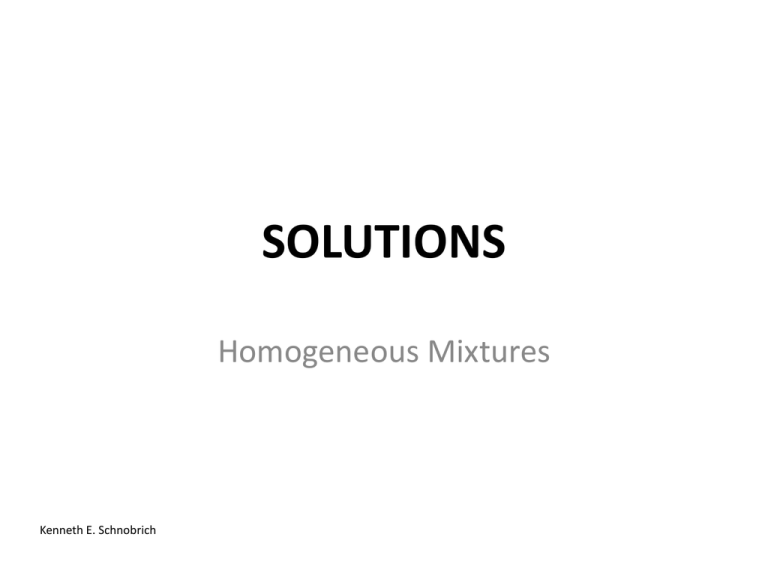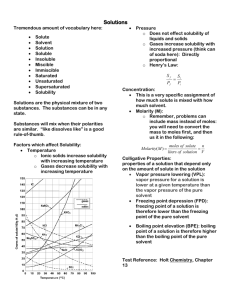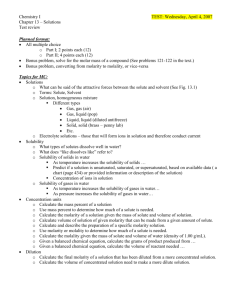solutions - New York Science Teacher
advertisement

SOLUTIONS Homogeneous Mixtures Kenneth E. Schnobrich Solution - Definition • A solution is a homogeneous mixture of two or more substances (elements or compounds) in no definite ratio by mass. • All homogeneous mixtures are solutions. • Solutions can exist in any phase (see the next slide). • Liquid solutions must be clear and can be colored. Terminology • Solute - substance that is being dissolved (lesser amount) • Solvent - substance that is doing the dissolving (greater amount) • Aqueous solutions - water solutions (water is the solvent) – KCl(s) -> K+(aq) + Cl-(aq) – Tyndall Effect Note the (aq) to indicate a water solution • When a light beam passes through a true solution the particle sizes are very small, so light is not dispersed. Terminology (cont.) • Electrolyte - aqueous solution that will conduct an electric current (ions must be present) • Nonelectrolyte – no ions are present (water by itself is a nonelectrolyte/ a solution of alcohol and water). • Solubility - the amount of solute that will dissolve in a given amount of solvent at a certain temperature. • Dissociation - breaking apart into its ions – KCl(s) -> K+(aq) + Cl-(aq) • Miscible - mixable (water & alcohol) • Immiscible - will not mix (oil & water) Solution Types Solvent/ Solute Solid Liquid Gas Solid Liquid Gas Alloys Salt water Brass(Zn/ Cu) Amalgams Alcohol & water H2 in Pt Soda Air Solubility Factors • It is important to distinguish between factors that speed up solubility and those that change the solubility. The following have an effect on how much will go into solution – Nature of the solute and solvent – Temperature – Pressure (gases) Solubility Factors • The following will effect how fast something goes into solution – Surface Area – Stirring Nature of the Substances Solute Type Nonpolar Non Polar Solvent Soluble Polar Solvent Insoluble Polar Insoluble Soluble Ionic Insoluble Soluble “Like Dissolves Like” In chemistry the phrase is used to describe how solutes and solvents will interact with each other. In Both cases the substances are soluble water CCl4 liquid ethanol Both polar I2 solid Both nonpolar *Visual from Odyssey by WaveFunction Polar vs Nonpolar Yellow dashed line shows hydrogen bonding between water molecules Polar water molecules Both of these substances exist in the liquid state at normal room temperatures. The hydrogen bonding in water is relatively strong and does not allow the mixing of the two substances. A visible boundary can be observed between the two substances. They are said to be immiscible and are an excellent example of “like dissolves like.” *Visual from Odyssey by WaveFunction Nonpolar carbon tetrachloride molecules “Like Dissolves Like” Substance Formula Solubility (g/L H2O) Methanol CH3OH Completely soluble Ethanol CH3CH2OH Completely soluble Propanol CH3CH2CH2OH Completely soluble Butanol CH3CH2CH2CH2OH 74 Pentanol CH3CH2CH2CH2CH2OH 27 Hexanol CH3CH2CH2CH2CH2CH2OH 6.0 Heptanol CH3CH2CH2CH2CH2CH2CH2OH 1.7 *Data taken from - Chemistry: Principles & Reactions, Masterton/Hurley, 1989, Holt, Rinehart and Winston, Inc. As the length of the hydrocarbon chain increases the molecule becomes less polar and its solubility in water decreases because it is becoming less like the “polar” water molecule THE SOLUTION PROCESS FOR Sodium Chloride (NaCl) + Note - the (+) hydrogen end of the water Molecule is attracted to the (–) chloride ion + + + + + - - - Chloride ion (Cl-) + + + The water molecules hydrate the ions And hold them in solution Sodium ion (Na+) Polar Water Molecule Note - the (-) oxygen end of the water Molecule is attracted to the (+) sodium ion *Visual from Odyssey by WaveFunction Nature of the Substances (cont.) • Refer to Table F of your Reference Tables for Chemistry • Note that they are talking about the solubility in aqueous solutions – AgCl - insoluble – PbSO4 - insoluble – (NH4)2CrO4 - soluble – Ag2S - insoluble *NYS Reference Tables for Chemistry TEMPERATURE • Refer to Table G of your Reference Tables for Chemistry – The solubility of most solids increases with an increase in temperature – The solubility of gases decreases with an increase in temperature • You must be able to interpret questions related to Table G (see next slide) Temperature & Solubility These substances are gases •Notice that the solubility of the gases increases with an increase in temperature •The solubility of most solids (those on the table) increases with an increase in temperature •The solubility is given in grams of solute per 100 grams of water *NYS Reference Tables for Chemistry PRESSURE Henry’s Law describes how pressure changes the solubility of a gas as the partial pressure of the gas above a liquid increases its solubility increases Pressure increasing Solubility increasing Grams solute/100 g H2O Solution Conditions Supersaturated Unsaturated Saturated Temperature(°C) Solution Conditions • Unsaturated - the solution can dissolve more solute in the solvent at the specified temperature. • Saturated - the solution is holding as much solute as it can hold at the given temperature ( the rate of solution equals the rate of dissolution). • Supersaturated - the solution is holding more solute than it normally can hold at the specified temperature. These solutions are unstable and will seek to reach saturation when disturbed and the excess solute will precipitate out. Units of Concentration • When talking about solutions there are several ways to express the amount of solute in solution (concentration) – Mass percent of solute – Parts per million (ppm) or parts per billion (ppb) – Molarity – Molality • Table T of your Reference tables should be used Mass Percent of Solute • On Table T you will see the following relationship – – Mass % solute = (mass solute/total solution mass) x (100) – Example – In a solution prepared by dissolving 24 g of NaCl in 152 g of water, what is the % by mass of NaCl in solution? – Solution – Mass % NaCl = (24 g/176 g) x 100 = 14 ppm & ppb • On Table T you will see the following relationships – ppm solute = (mass solute/total solution mass) x 106 – ppb solute = (mass solute/total solution mass) x 109 • There is a relationship between mass percent and ppm and ppb – ppm = mass percent x 104 – ppb = mass percent x 107 ppm Example • Example – In the United States and Canada, drinking water cannot contain more than 5 x 10-4 mg of mercury per gram of sample. In parts per million what would that be? • Solution – – Ppm Hg = (5 x 10-4 mg Hg/1 x 103 mg) x 106 = 0.5 Remember there are 1000 mg = 1 gram) Molarity • Molarity (M) is a very common concentration unit used in preparing lab solutions. • Remember – mols (n) = #g/mw • Formula from Table G – M = #mols/#L of solution – Example – if 40 g of NaOH is dissolved in water to prepare 500 mL of solution, what is the molarity? – M = 1 mol/0.5 L = 2M (or a 2 molar solution) MW of NaOH = 40 g/ mol Molarity Problems • Fill-in the following blanks Substance KOH # grams used L of solution 100 2.0 CaCl2 0.5 NH4NO3 160 Ca(OH)2 80 Molarity (M) 2.0 1.0 1.5 Molarity Dilution Problems • The number of mols of solute in a sample remains constant when we add water to dilute the sample, the concentration changes. • M1V1 = M2V2 - 1 & 2 represent the original solution and the diluted solution molarity and volume. • If a 200 mL of a 3.0 M HCl solution is diluted to 400 mL what is the new molarity? – M2 = (200 mL)(3.0 M)/(400 mL) = 1.5 M Molality (m) • Molality is another unit of concentration and should not be confused with molarity. In this case, we know the amount of solute and solvent. • Formula – m = #mols solute/#kg solvent • Example – A solution contains 12.0 g of glucose, C6H12O6, in 95grams of water. Calculate the molarity. – m = 0.0667 mols/0.095 kg = 0.702 m MW of glucose = 180 g/mol Colligative Properties • Colligative properties refers to properties of a solution that depend on the concentration of particles. • Generally these properties are measured for dilute solutions (at high concentrations there are other interactions that take place). • Vapor pressure, boiling point, and freezing point are changed by particle concentration. Vapor Pressure • Vapor pressure can be described as the pressure exerted by the vapor above a liquid against the opposing atmospheric pressure. When a nonvolatile substance like sugar or salt are added to water they lower the vapor pressure. • How do they lower the vapor pressure? – Some of the nonvolatile particles are at the surface and they interfere with the escape of the volatile water molecules – Since the volatile water molecules need a certain amount of kinetic energy to escape, the number gaining enough energy to escape is less because the nonvolatile particles have absorbed some of that energy Vapor Pressure Lowering Notice the decrease in gaseous water molecules as a result the introduction of the nonvolatile sodium ions and chloride ions from NaCl. The vapor pressure is lowered. Chloride ion Sodium ion NaCl (aq) *Visuals done using Spartan Model by WaveFunction Vapor Pressure • As you look at table H for the four liquids you can make the general statement – “as temperature increases the vapor pressure increases.” The differences in vapor pressure are a function of the attractive forces between the molecules in each of the liquids. The lower the attractive forces the higher the vapor pressure at a given temperature. • The hydrogen bonding in water gives it a reasonably lower vapor pressure than ethanol and propanone. Boiling Point • Boiling Point is defined as the temperature at which the vapor pressure equals the opposing standard atmospheric pressure. • When a nonvolatile particles are added to water to make a solution, the boiling point of that solution is raised. Chloride ion Sodium ion Water boils at 100°C at 1 atm NaCl solution at > 100°C at 1 atm *Visuals done using Spartan Model by WaveFunction Boiling Point (cont.) • The elevation of the boiling point depends on the number of mols of particles present. For each mol of particles in a kg of water the boiling point of the aqueous solution is elevated by 0.52°C. That is called the boiling point elevation constant for water (0.52°C/m). • Molecular compounds such as C6H12O6 do not break up into ions, so one mol of C6H12O6 would raise the boiling point 0.52°C. • Ionic Compounds such as NaCl and CaCl2 break up into ions in aqueous solution. One mol of NaCl actually yields two mols of ions, one mol of CaCl2 yields three mols of ions. They would elevate the boiling point more than one mol of C6H12O6. Freezing Point • When water freezes the hydrogen bonds give water a rigid structure (water expands as it freezes). The solid water has a definite crystalline structure as a result of the hydrogen bonding • Adding NaCl or C6H12O6 (any solute) to the water interferes with the formation of the hydrogen bonds. The freezing point of an aqueous solution is lowered 1.86°C for each mol of particles per kg of water (1.86°C/m). *Visual from Odyssey by WaveFunction






